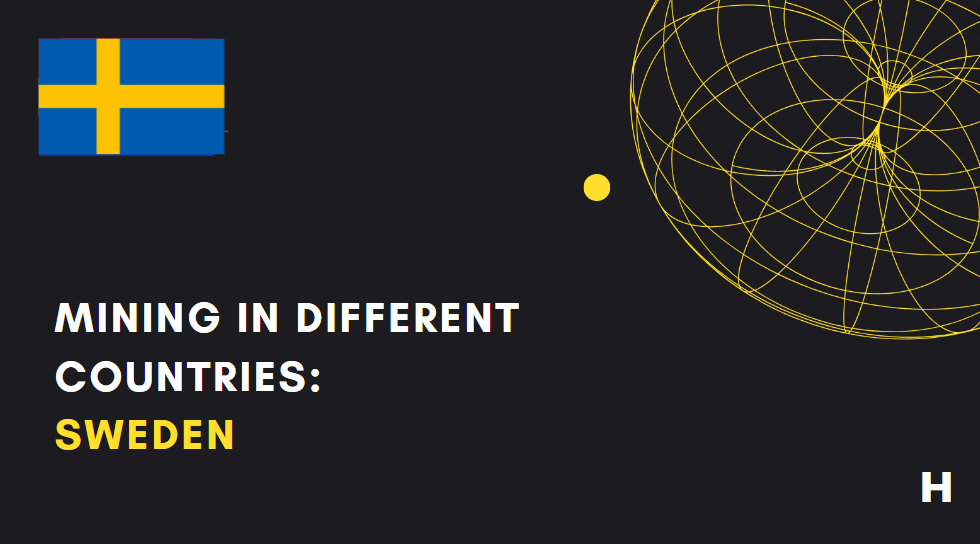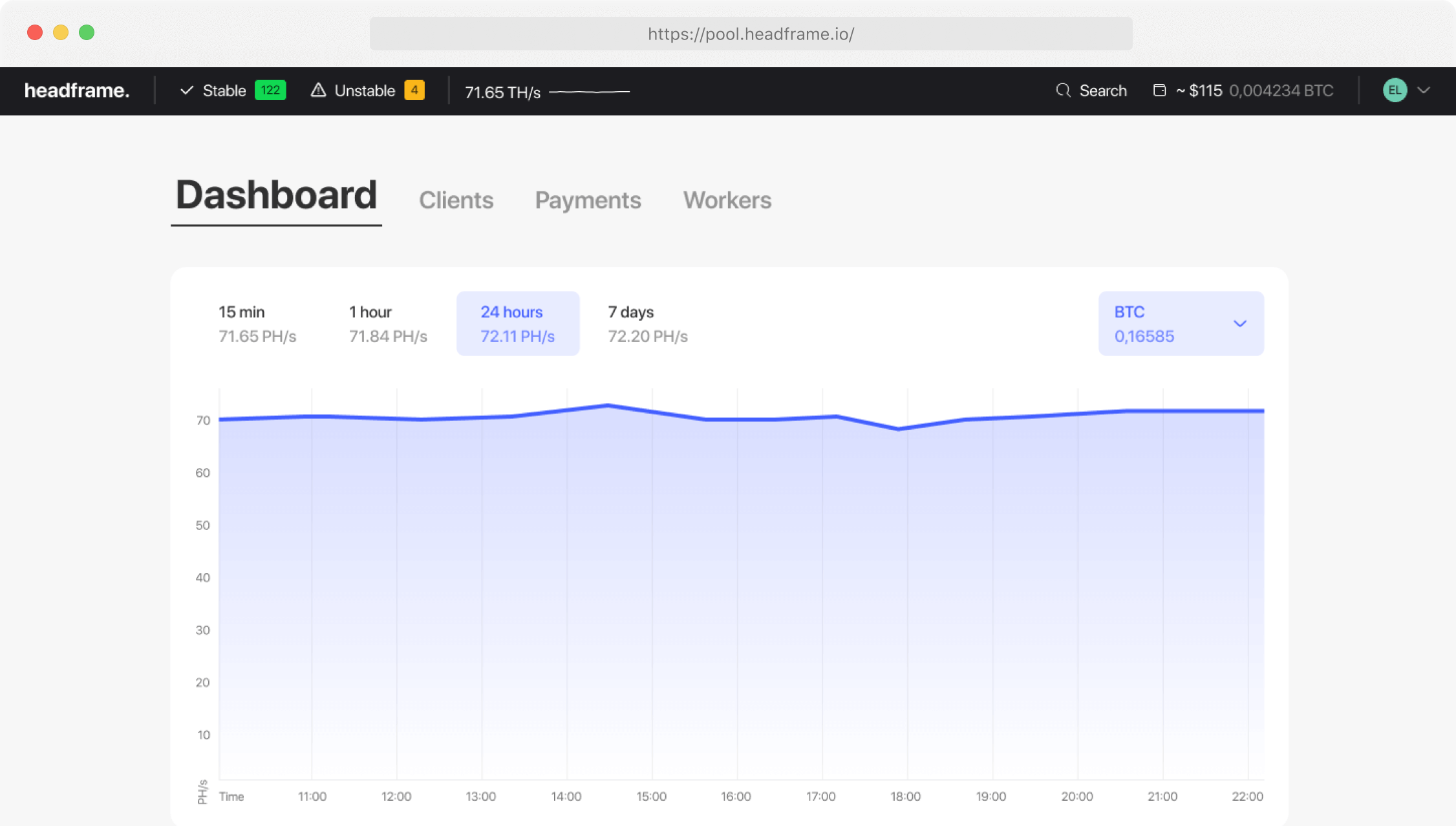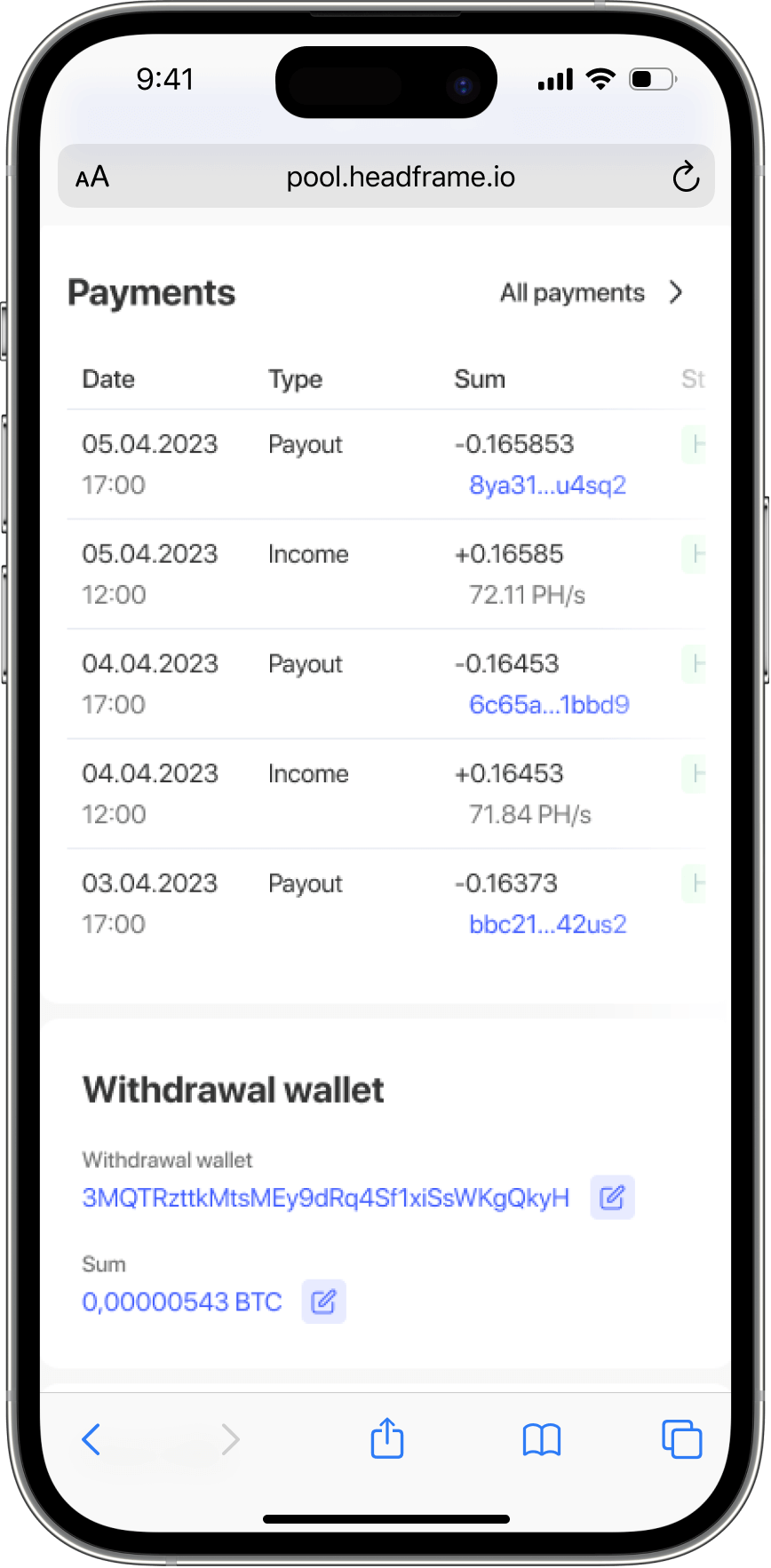
Mining in Sweden
Sweden has become one of the last bitcoin mining havens in Europe thanks to hydroelectric power outages. But what else is driving the bitcoin mining industry in this Arctic outpost?
Earn more money with Headframe
Join a mining pool and get the best profitability in mining. Already more than 10,000 miners trust Headframe.
- One of Europe’s latest bitcoin mining havens
- Who is mining bitcoin in Sweden?
- Electricity is only cheap in the north of the country
- Will electricity remain cheap in northern Sweden?
- Sweden provides excellent conditions for bitcoin mining
- Politically stable country, but bitcoin mining is controversial
- Conclusion
One of Europe’s latest bitcoin mining havens
Let’s first determine the size of the bitcoin mining industry in Sweden.
Cambridge University periodically publishes a bitcoin mining map, estimating the share of hashrate attributable to different countries. According to the latest version for January 2022, Swedish miners generate 0.84% of Bitcoin hashrate. Multiplying this percentage by the power consumption of the Bitcoin network at that time, we get that the power consumption of Swedish Bitcoin miners is 80 MW.
Cambridge’s estimate was made over a year ago and is based on a top-down methodology using data from only four mining pools.
According to other estimates, the Swedish bitcoin mining industry consumes about 150 MW. This energy consumption should correspond to a Swedish share of global hashrate production of 1.8%, based on the Hashrate Index of bitcoin mining energy consumption, which currently stands at 8.1 GW. In addition, Sweden is home to several GPU powerhouses that mined ether before the merger and now mine altcoins or do high-performance computing.
Who is mining bitcoin in Sweden?
Miners from Sweden, generating more than 1% of the bitcoin hashrate, are not the largest but still important players in securing the bitcoin network. Who are they and where do they work?
The Swedish bitcoin mining industry consists of several international players and several local data centers engaged in mining as one of many activities. The most notable international players are Hive Blockchain, Northern Data and Genesis Digital Assets.
The entire industry is located in the northern part of the country where there is access to a large amount of untapped renewable energy. The largest mining center in the region is Boden, a small industrial town where Hive Blockchain and Northern Data operate.
The main reason Sweden has attracted a significant bitcoin mining industry is the abundance of renewable energy. Sweden is an energy powerhouse and will produce the fifth highest amount of electricity per capita in the world in 2021.
Sweden has become a popular destination for bitcoin miners seeking carbon neutrality as 98% of its electricity comes from clean sources. Hydro and nuclear power plants form the backbone of the electricity system, with a 44% and 31% share respectively. The country also has a growing share of wind power, which currently stands at 16%.
Sweden is a large country with varied topography. In the north of the country, numerous rivers carry water from the mountains along the Norwegian border to the Gulf of Bothnia. This terrain is ideal for hydropower, and the hard-working Swedes have taken advantage of it, with a total hydroelectric capacity of 16.4 GW.
The landscape in the south of the country is flat, and there are few rivers suitable for hydropower generation. The Swedes solved this problem by creating several nuclear power plants in the 1970s. Initially, the Swedish government planned to phase out nuclear power, but the current energy crisis in Europe has forced them to change their mind. Most likely, Sweden will not follow Germany’s example and jeopardize its energy security by reducing nuclear capabilities.
Electricity is cheap only in the north of the country
Sweden is the third largest country in Europe by area. Most of the country’s 10 million people live in the southern part of the country. However, as discussed in the previous section, almost all hydropower is generated in the north of the country.
The huge distances between the northern hydroelectric plants and the demand centers in the south make it difficult to build the necessary transmission capacity to interconnect these isolated nodes. Therefore, there are significant transmission constraints between the north and south, preventing the outflow of zero marginal cost hydropower from the north.
Due to transmission constraints, the Swedes have divided their market into four price zones. In this paper, we will refer to the two northernmost price zones as “northern Sweden” and the two southernmost price zones as “southern Sweden”. Electricity is cheap in the north of the country and expensive in the south.
Electricity prices in southern Sweden have not always been high. Historically, electricity prices have been equally low in the northern and southern parts of the country, but in 2021 there are unexpectedly large price differences. Southern Sweden is well connected to the European electricity market through submarine cables. Therefore, the sharp increase in electricity prices in Europe from the second half of 2021 quickly spread to southern Sweden.
Between 2018 and 2020, the average spot price for electricity in southern Sweden was only 41 dollars per MWh. In 2021, the price rose to $82 per MWh, making bitcoin mining prohibitively expensive. In 2022, the average price reached an unprecedented $148 per MWh, putting even the most energy-efficient ASICs into negative cash flow territory. This increase in electricity prices has bankrupted miners in southern Sweden, who have gone bankrupt or moved north.
At the same time, electricity prices in northern Sweden have remained at about the same level as before the energy crisis. Significant transmission restrictions between north and south Sweden have protected electricity consumers in northern Sweden from the most severe electricity price inflation. Our recently published 2022 year-end report describes how the energy crisis has affected the bitcoin mining industry.
According to industry representatives, miners in Sweden can expect to see an average annual electricity price decrease by about 25% due to demand response initiatives. For example, Hive, a company operating in Sweden, announced in December that it had made significant profits by reducing electricity consumption in response to market signals.
Will electricity remain cheap in northern Sweden?
The previous section established that electricity is cheap in northern Sweden. But will it remain so?
Three factors can influence the dynamics of electricity prices in northern Sweden: the development of local generation capacity, changes in local electricity demand, and the expansion of transmission capacity between northern and southern Sweden. Let us evaluate these three factors one by one.
As already mentioned, the backbone of the electricity system in northern Sweden is hydropower. Unfortunately, there are no plans to build additional hydropower capacities. The only increase in generation capacity in northern Sweden in the near future will come from wind power, which is estimated to increase by 22% between 2023 and 2027.
Total electricity generation capacity in northern Sweden will increase by 11% between 2023 and 2027, which corresponds to a marginal increase of 2.6% per year. More worryingly, all of the capacity increase will come from weather-dependent wind power, whose capacity factor is much lower than that of hydropower. Supply constraints leave little room to increase demand without raising prices.
This leads us to the next question: how will local electricity demand in northern Sweden develop in the coming years? It is likely to increase significantly as several large industrial projects that require large amounts of electricity are being developed. These industrial companies are attracted to northern Sweden because of the difference in electricity prices between traditional industrial centers such as Germany and northern Sweden.
These industrial projects are largely linked to the EU’s and Sweden’s energy transition ambitions: they include battery plants, green steel production and the electrification of Europe’s largest iron ore mine. All these projects will require huge amounts of electricity. For example, the electrolyzer that will produce hydrogen for green steel production will consume 800 MW by 2030 – five times more than the entire Swedish bitcoin mining industry. Even more electricity will be needed to electrify the iron ore mine – by 2030, it will be about 2,300 MW.
We now know that electricity demand in northern Sweden will grow significantly without a corresponding increase in generating capacity. Next, let’s analyze the last factor: the development of transmission capacity.
The Swedish System Operator plans to remove transmission constraints between northern and southern Sweden by investing heavily in transmission capacity development as part of the NordSyd project. However, these works will take up to 20 years to complete, so the electricity markets in northern and southern Sweden will remain relatively separate for the foreseeable future.
Due to the projected huge increase in industrial electricity demand by 2030, prices in northern Sweden are expected to converge with higher prices in southern Sweden. However, miners in northern Sweden will likely continue to enjoy low electricity prices for at least three to five years.
Sweden provides excellent conditions for bitcoin mining
There are few countries in which operating a mining farm is easier than Sweden. The cold climate of this Arctic country provides natural cooling for heat-generating mining operations. Average monthly temperatures in Boden, the bitcoin mining capital of Sweden, range from -9C (-15F) to +17C (+62F) during the coldest and warmest months. The air is also very clean. For bitcoin mining, the climate could hardly be better.
The favorable climate means that maintaining and operating a mining operation is easier than in hotter bitcoin mining centers like West Texas. Miners can easily run air-cooled machines and don’t have to worry about building additional cooling infrastructure. In addition, the machines can last longer.
The low failure rate due to the cold climate also means less need for maintenance, which can lead to lower operating costs. I’ve heard of some small mining companies in the area that sometimes leave their facility running for weeks at a time with no employees present except for periodic safety checks. Try doing this in West Texas during the scorching summer heat.
In addition, even the sparsely populated north of Sweden provides decent access to labor. The most suitable locations for mining are relatively close to cities with a population of at least 20,000, and the population tends to be IT savvy, as the region is home to one of Sweden’s leading IT universities.
A politically stable country, but bitcoin mining is highly controversial
Sweden has historically been one of the most politically stable countries in the world. Its political and regulatory bodies have traditionally been business-friendly and open to innovation, as evidenced by the country being ranked 10th in the World Bank’s Ease of Doing Business Index. The low level of political risk, favorable regulatory framework and general business friendliness contribute to the creation of an innovative business climate, which has led to the formation of one of Europe’s leading IT industries.
Taxes in Sweden are relatively low compared to many European countries: the corporate tax rate is 21%. On the other hand, the VAT rate is 25%, which also affects imported products, including ASICs. Nevertheless, Swedish miners can avoid import VAT by registering their companies in the Swedish VAT registry.
The country has a large conventional data center industry, represented by companies such as Facebook, Google, Microsoft and Amazon. The Swedish government is keen to attract data centers, especially in the northern part of the country, and has even assisted them in setting up operations. Swedish power producers have also taken initiatives to attract energy-intensive data centers, including bitcoin miners.
However, bitcoin mining remains controversial on a political level. Swedish politicians and regulators have consistently expressed negative attitudes towards the industry. The most prominent example dates back to 2022, when two Swedish financial regulators tried to get the EU to ban proof-of-work. Fortunately, they were unsuccessful.
Although the attempt to ban bitcoin mining failed, Swedish officials continue to look for ways to restrict the industry, with Sweden’s energy minister stating, “We need energy for more useful things than bitcoin.”
Currently, Swedish miners, as part of the broader data center industry, are entitled to a preferential electricity tax of SEK 0.006 ($0.00057) per kWh, compared to the usual SEK 0.392 ($0.038) per kWh. The Swedish government has proposed to remove the eligibility of data centers for the preferential electricity tax from July 1, 2023. Unfortunately, there appears to be a broad political consensus to increase the electricity tax, and miners will likely have to pay the tax from July 1.
In northern Sweden, competition for grid connections is very high due to the massive influx of electricity-intensive industries. These industries receive significant support from the Swedish government and the EU and are likely to win the battle for electricity distribution in the future. Swedish miners are already finding it increasingly difficult to access new electricity.
Conclusion
Thanks to cheap renewable energy, a cold climate and political stability, Sweden has developed a significant mining sector generating over 1% of the bitcoin hashrate.
The scarcity of hydroelectricity has spared northern Sweden from the energy price inflation gripping Europe at the end of 2021, and has made the region one of the last havens for bitcoin mining in Europe. It’s important to note that electricity is only cheap in the north of Sweden, but not in the southern part of the country.
Sweden has historically been a politically stable country with an excellent regulatory environment for most businesses. However, bitcoin mining remains controversial. Swedish regulators are looking to scale back the industry to make room for other electricity-intensive industries in line with Swedish and EU ambitions, and have recently proposed raising electricity taxes from July 1, 2023.
Competition for electricity with these government-approved industries gives the Swedish bitcoin mining industry little room for growth. In addition to increasing political opposition, there is also a significant risk of rising electricity prices. The massive growth in industrial energy consumption in northern Sweden is likely to cause electricity prices in this region to rise sharply over time.
However, as these industrial projects take time to develop, bitcoin miners likely have at least three to five more good years of operation in a stable country with low electricity prices and excellent operating conditions.
Source: https://hashrateindex.com/blog/bitcoin-mining-around-the-world-sweden/


